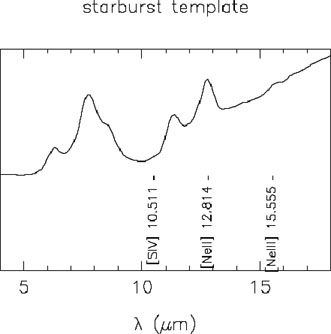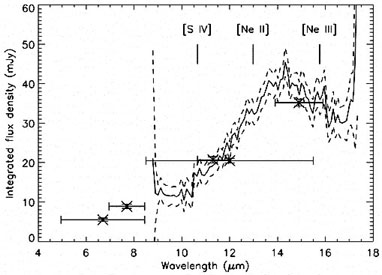![]()
Low Metallicity Galaxies
| Salvador Dali demonstrated that low metallicity can profoundly affect the properties of objects. His low metallicity watches have such limp cases they cannot hold themselves up, but just sag under gravity. Similarly, we want to use MIPS to see how low metallicity affects the properties of star forming galaxies. Of course, to astronomers, "metals" include any elements heavier than hydrogen and helium, not just the ones in watch cases. (from http://www.a-reny.com/iexplorer/musicf.html) |  |
| ISO observations provide a hint of one thing we might see. To the left below is an average spectrum of a suite of solar metallicity galaxies. They show a bright feature just short of 8 microns, and another fainter one at 11.3 microns (between [SIV] and [NeII]). These features are from tiny dust grains in the interstellar material of the galaxies. To the right is a spectrum of a very low metallicity (about 2% of solar) galaxy. The 11.3 micron feature is missing, and the point just short of 8 microns obtained with filter photometry shows no trace of the one there either. Something seems to be very different about the interstellar dust. | |
 |
 |
These observations are a tantalizing hint, but we need better data and on more galaxies to understand what is really happening. The MIPS program is coordinated with one by the IRS team to characterize a large number of these galaxies fully. Not only are they of intrinsic interest, but we also expect that galaxies forming early in the life of the Universe will have lower metallicity than is typical of nearby ones, because there will have been less time for massive stars to manufacture and release the heavy elements in them. Understanding the nearby low metallicity galaxies may be critical to understanding galaxies at high redshift in general.